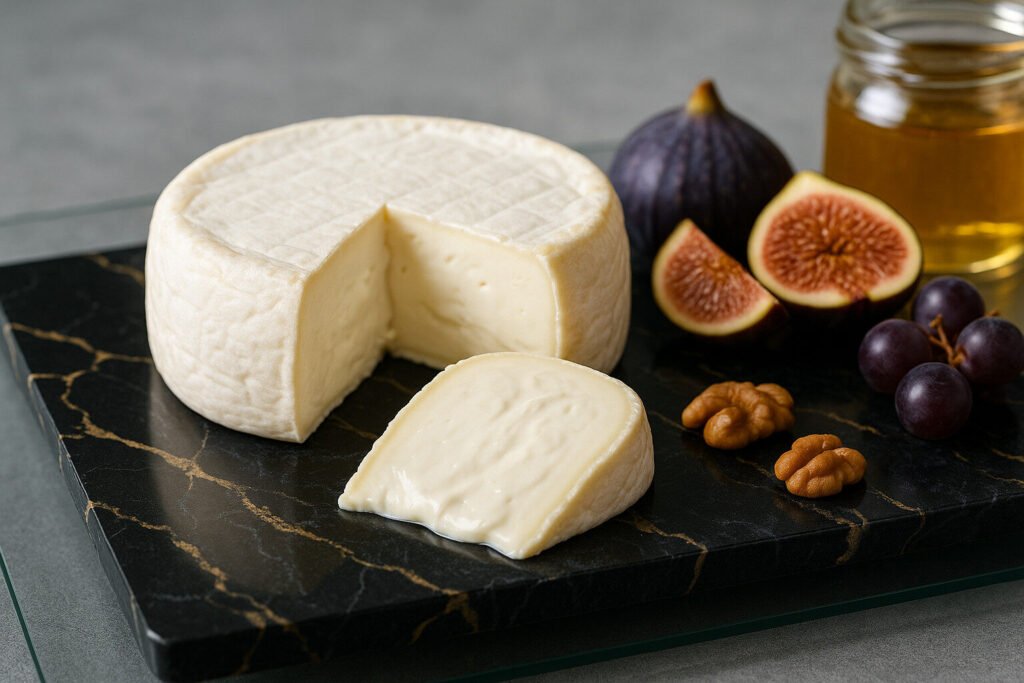Robiola Cheese
Definition and Scope
Robiola is a soft-ripened Italian cheese made from varying combinations of cow’s, goat’s, and sheep’s milk. It belongs to the Stracchino family of cheeses, characterized by their high moisture content and brief aging periods. The name “Robiola” historically refers to cheeses from the Piedmont and Lombardy regions, though production now occurs elsewhere.
This cheese is defined by its bloomy rind and creamy, spreadable texture. Its composition is not strictly regulated, allowing for significant variation in milk ratios between producers. Robiola is typically sold in small, cylindrical forms and weighs between 300 to 500 grams. The cheese reaches maturity within 10 to 20 days of production.
Production Process
Robiola production begins with raw or pasteurized milk that is warmed and inoculated with lactic ferments. Animal rennet is added to coagulate the milk, forming a delicate curd within 12-18 hours. The curd is carefully hand-ladled into perforated molds to preserve its fragile structure. This gentle handling prevents excessive whey expulsion.
After draining for 24 hours, the cheeses are dry-salted or brine-washed and transferred to aging cellars. They develop a characteristic white Penicillium mold rind during 10-20 days of affinage. The humidity remains at 85-90% while temperatures stay between 10-13°C. Frequent turning ensures even rind development and prevents moisture pooling.
Sensory Profile
Robiola presents a thin, edible white rind with a pale ivory paste that becomes increasingly fluid with age. Its texture ranges from tender and cake-like in young versions to creamy and spoonable when fully ripe. The cheese offers notable yield under slight pressure, indicating proper maturation. Surface blooming should appear even and velvety without discoloration.
Flavor profiles vary from mildly lactic and tangy in fresh Robiola to more complex mushroom and fermented notes in aged versions. Goat’s milk versions contribute herbaceous tones while sheep’s milk adds nutty undertones. The finish is typically clean with balanced acidity. Aroma characteristics include fresh yeast, cultured butter, and subtle cellar notes.
Culinary Applications
Robiola serves primarily as a table cheese, often accompanied by fruit preserves or honey. Its creamy consistency makes it ideal for spreading on crusty bread or crackers. The cheese pairs exceptionally with sparkling wines like Prosecco and light reds such as Dolcetto. Fresh figs, pears, and walnuts complement its delicate flavors.
In cooked applications, Robiola melts smoothly into risottos and polenta during final stages of preparation. It enhances pasta fillings for ravioli and adds richness to vegetable gratins. Professional kitchens frequently incorporate it into cheese boards for its textural contrast. The cheese should be served at room temperature to maximize flavor release.
Regional Variations
Robiola di Roccaverano holds DOP status and must contain at least 50% goat’s milk from local breeds. This version from Asti province features a more pronounced tang and firmer texture. Production follows strict traditional methods using raw milk and natural fermentation. The rind develops characteristic blue-grey mold spots during aging.
Lombardy produces Robiola Lombardia using primarily cow’s milk with smaller percentages of ovine and caprine milk. This variation tends toward milder flavors and softer texture. Piedmontese examples often include all three milk types in balanced proportions. Modern interpretations sometimes incorporate truffles or herbs during the aging process.

